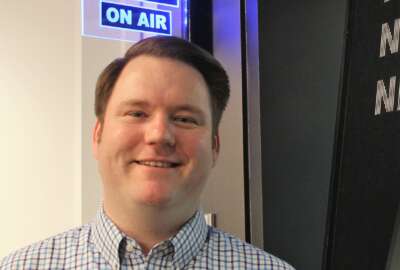
How did local governments hold up during the 2020 election?
The bipartisan Election Assistance Commission has been advising local election officials on how to meet the requirements of the Help America Vote Act to ensure vote...
Best listening experience is on Chrome, Firefox or Safari. Subscribe to Federal Drive’s daily audio interviews on Apple Podcasts or PodcastOne.
The bipartisan Election Assistance Commission has been advising local election officials on how to meet the requirements of the Help America Vote Act to ensure vote access and sound systems for handling ballots. We spoke to our next guest back in April, when the 2020 election seemed a ways off. Now that’s its over, Federal Drive with Tom Temin checked in again with the chairman of the Election Assistance Commission, Ben Hovland.
Interview transcript:
Tom Temin: Mr. Hovland, good to have you back.
Ben Hovland: Hi Tom, thanks for having me. It’s great to be here.
Tom Temin: Well there have been charges and countercharges of widespread election fraud. It looks like we’re coming to the end of this whole painful process of the aftermath. And really only in a few concentrated areas of the country has this been disputed. What’s your assessment of how well the local jurisdictions took the advice of the EAC and generally conducted their elections?
Ben Hovland
Tom, the state and local election officials that are responsible for running our elections all over the country did an amazing job this year. It’s really unfortunate that some of the rhetoric we’ve been hearing lately has distracted from that. But the true story of the 2020 election is really about the amazing job that state and local election administrators did in the face of unprecedented challenges.Tom Temin: Because a lot of people, of course, had their eyes riveted on those zones that came in late that had a lot of absentee ballots, Philadelphia, Pittsburgh, and so on. But that’s only a small number of the jurisdictions. Give us a sense of how many voter jurisdictions there really are that to make up the vast number, I think there’s 9000 counties or something in the United States.
Ben Hovland: So each of the 50 states runs elections in its own unique way. And there are nearly 9000 election jurisdictions across the country. That means there’s a lot of variation. There’s a lot of differences in how people do elections. You mentioned some of the later counting of absentee and mail ballot in places like Pennsylvania, a number of those states that were in the news, Pennsylvania, Wisconsin, Michigan, their state legislatures made decisions about the timeline when the processing of those ballots could begin. Certainly, that was part of why there was the time lag as far as what people are accustomed to. I think that will be some of the type of things that people are looking at as they look at lessons learned out of this election. But again, those processes, those procedures have all been set out in state law. They’re all normal. They all happen every election year. The only difference really this year was some of the volume, you had record setting amounts of mail and absentee ballots, you had a record amount of early in person voting, and ultimately, we saw nearly 160 million Americans make their voices heard this year, which is the most Americans to ever vote in an election.
Tom Temin: And is it accurate to say that the gold standard for elections is to have everybody show up in person on the same day, their name crossed off, they go home, and that’s it — is that still ultimately the best way to do it?
Ben Hovland: That certainly wouldn’t have been the best way to do it this year with the pandemic. Working with our partners at Centers for Disease Control, one of the things, and other federal partners as well as our state local partners, we’ve been pushing out the idea that it was important to have voters spread their vote out this year. And we saw them do that, again, you saw record amounts of mail and absentee voting, you saw record amounts of early in person voting, but you still saw nearly 60 million Americans cast their ballot on election day. And all those were great options. The important piece was that Americans had options, they were able to choose the way they felt most comfortable participating this year. And ultimately, they were able to make their voices heard.
Tom Temin: And would you say then that there are lessons learned from the mail experience this year? I mean, it was kind of messy. But in the end that seemed to work for the most part, I mailed in my own ballot and got confirmations of receipt and confirmations of it having been counted from my jurisdiction. What are the lessons learned here for the next time around?
Ben Hovland: I had that same experience. I mailed my ballot as well got an email confirmation from the state, which was great. But I think there were a few things. Number one, as I said earlier, each state runs elections a little differently. And so one of the real important stories that hasn’t been told as much as it should be this year is how that decentralized nature of elections, that innovation that had happened around the country really mattered this year. You had states like Washington and Oregon, Colorado and Utah that had already transition to full mail and absentee ballot systems. And they were able to share those lessons that they learned over years or decades with their colleagues across the country. And that was a big deal. But there were certainly, a lot of states they were on a tight timeline to make certain decisions. And there were resource limitations. And so I think you’ll see a lot of states or jurisdictions with a little bit more time, hopefully with some additional resources, looking at ways they can update either their laws or some of their procedures. We both mentioned that we were able to track our balance, I think that’s a big piece of giving voters confidence in the system. A number of states have that. But certainly, I think, number one, any states that don’t would probably be looking at it. And then number two, we do see places like Denver that have been doing this longer, have more bells and whistles with their ballot tracking, they’re able to give their voters more information, text messages, telling them where it is in the process, or that their signature has been verified, or it’s been counted. I think all those things lend to voter confidence. And those will be the types of things that we’re looking at at the EAC as we look at the different ways states around the country adapted to the pandemic. And again, the great work that state local election officials did around the country, but looking at how we can share that and everyone can keep getting better. And our elections in the future will be run even better than they were.
Tom Temin: What’s your sense of the cyber security question, because that was coming up for the prior year, with respect to not so much the balancing systems themselves, although there were allegations made about the electronic machine companies. But what I was referring to was the state or jurisdictional owned databases of registered voters.
Ben Hovland: A big piece of looking at the sort of cyber security of our election space has been the January 2017 critical infrastructure designation that has really led to a sea change in information sharing, it’s been extremely important. That critical infrastructure governance sub structure made a big deal this year. The government Coordinating Council, the Sector Coordinating Council, essentially, that was state, local, federal partners, along with private sector partners, able to share information very quickly about elections and developments and work together, both in response to the pandemic, but then also as it related to cyber security issues, we’re able to have unprecedented levels of visibility across the country. And in particular, this mattered, you know, throughout, but like on election day, I was at the Cybersecurity Infrastructure and Security Agency, and their operation center. And again, we had people from all these stakeholder groups, as well as communications around the country. And as issues popped up, we were able to see those basically in real time and very quickly ascertain if these were regular election issues that we see every election, or if there was something larger, and be able to share that information with media partners and others before maybe it snowballed into something else. So certainly those were all big steps this year, and a good improvement. I think one of the real pieces of, whenever you’re talking about cybersecurity though, you can’t pat yourself on the back too long. The nature of those threats, the nature, those challenges are ongoing. And so the work that state and local election officials have done, that federal partners have done since 2016, has mattered, it made a big difference. But that doesn’t mean we can take our foot off the gas, we need to continue to have investment into this era, we need to continue to be dedicated, vigilant to ensuring the security of our elections going forward.
Tom Temin: And as far as the Election Assistance Commission itself, the members are nominated by the president upon recommendation from members of Congress. And you and several other commissioners, I guess, are on borrowed time, so to speak with respect to your terms. What’s going to happen next with the commission and the commissioners?
Ben Hovland: The history of the EAC has been a little rough at times, we’ve been a political football, we’ve been kicked back and forth and talk of elimination in years past. I believe we’re past that. And I think the conversation is now how do we get better? And I think that’s important. Of course, part of that is ensuring that we have a quorum, and we aren’t in a situation without one, which has happened in the past. But the other part is having adequate funding. We hit an all time low on our funding in FY 19. That year, in 2019. I told Congress that the city of Kansas City, Missouri spends more on potholes than the federal government invests in the Election Assistance Commission. We did get a little bit of an increase. Sadly, the pothole reference holds true. Kansas City does still spend more on potholes than the federal government invests in the EAC. Again, we’ve had some indicators from Congress that that may change. I’m hopeful. The analogy actually plays out because the issues that we work on are the infrastructure of our democracy. Again, it’s working with state and local election officials to make sure that our democracy is working well, that our election administration is working well, that Americans are able to get registered to vote and participate in the process. And I think this year, the need for that work, the need for common sources of information sharing, common sources of trusted source data, are more apparent than they’ve ever been.
Tom Temin: Ben Hovland is chairman of the Election Assistance Commission. Thanks so much for joining me.
Ben Hovland: Thanks Tom.
Copyright © 2024 Federal News Network. All rights reserved. This website is not intended for users located within the European Economic Area.
Tom Temin is host of the Federal Drive and has been providing insight on federal technology and management issues for more than 30 years.
Follow @tteminWFED





